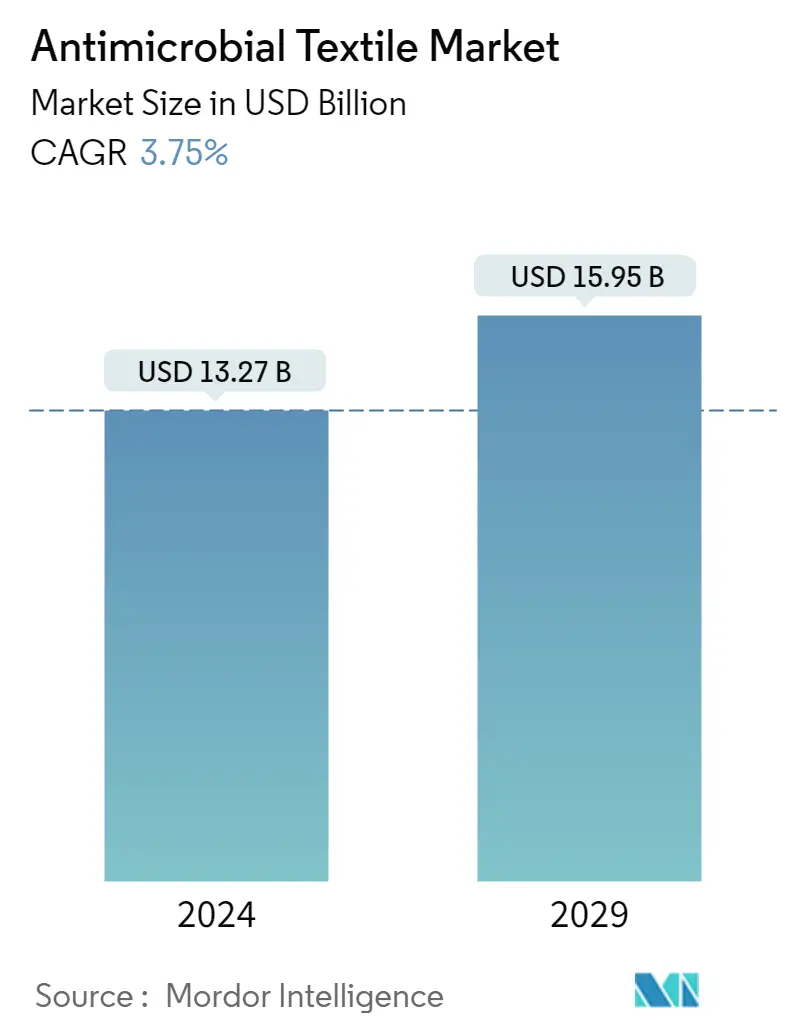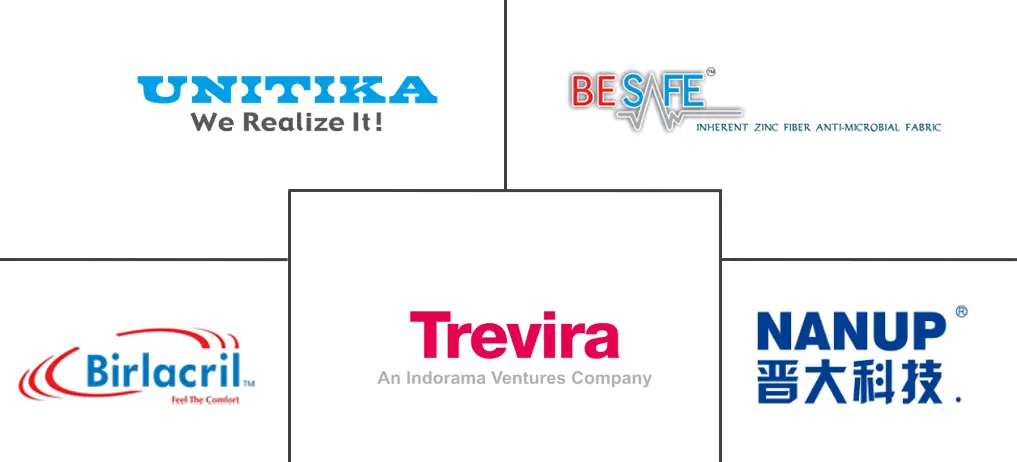Market Size of Antimicrobial Textile Industry

| Study Period | 2019 - 2029 |
| Market Size (2024) | USD 13.27 Billion |
| Market Size (2029) | USD 15.95 Billion |
| CAGR (2024 - 2029) | 3.75 % |
| Fastest Growing Market | Asia Pacific |
| Largest Market | North America |
Major Players
*Disclaimer: Major Players sorted in no particular order |
Antimicrobial Textiles Market Analysis
The Antimicrobial Textile Market size is estimated at USD 13.27 billion in 2024, and is expected to reach USD 15.95 billion by 2029, growing at a CAGR of 3.75% during the forecast period (2024-2029).
In the year 2020, due to the breakdown of Covid-19, the demand for microbial textiles increased. Since then, the demand for hygienic and protective textiles is increasing for various applications all over the globe.
- Factors such as growing demand from the healthcare industry and increasing application in sportswear are driving market growth.
- However, stringent environmental regulations are hindering the market growth.
- The development of non-toxic and bio-compatible products will act as an opportunity for the growth of the market during the forecast period.
- North America dominated the market across the globe with the largest consumption from the United States.
Antimicrobial Textiles Industry Segmentation
Antimicrobial textiles help in providing protection by killing microorganisms or bacteria. These textiles also help in preventing the spread of infections in hospitals. The market is segmented by type, application, and geography. By type, the market is segmented into Quaternary Ammonium, Triclosan, Cyclodextrin, Chitosan, and Others. By application, the market is segmented into Medical Textiles, Apparel, Home Textiles, Industrial Textiles, and Others. The report also covers the market size and forecasts for the antimicrobial textiles market in 15 countries across major regions. For each segment, the market sizing and forecasts have been done on the basis of revenue (USD).
| Type | |
| Quaternary Ammonium | |
| Triclosan | |
| Cyclodextrin | |
| Chitosan | |
| Others |
| Application | |
| Medical Textiles | |
| Apparel | |
| Home Textiles | |
| Industrial Textiles | |
| Others |
| Geography | |||||||
| |||||||
| |||||||
| |||||||
| |||||||
|
Antimicrobial Textile Market Size Summary
The antimicrobial textile market is experiencing a steady expansion, driven by increasing demand from the healthcare sector and the growing application of these textiles in sportswear. The market's growth trajectory was notably influenced by the COVID-19 pandemic, which heightened the need for hygienic and protective textiles globally. Despite the positive growth prospects, the market faces challenges due to stringent environmental regulations. However, the development of non-toxic and bio-compatible products presents significant opportunities for future growth. North America, particularly the United States, currently leads in market consumption, with substantial demand stemming from the healthcare industry, where antimicrobial textiles are utilized in various medical applications.
The Asia-Pacific region is anticipated to be the fastest-growing market for antimicrobial textiles, fueled by increasing public health awareness in countries like China, India, and Japan. This region is home to some of the largest producers of antimicrobial textiles, with companies such as Unitika Trading Co. Ltd, Birlacril, and Jinda Nano Tech (Xiamen) Co., Ltd playing pivotal roles. Recent infrastructure developments, such as the inauguration of a large private hospital in India and new hospital constructions in the Philippines, are expected to further drive demand for antimicrobial textiles. The global market remains highly fragmented, with numerous players holding marginal shares, indicating a competitive landscape with potential for growth and innovation.
Antimicrobial Textile Market Size - Table of Contents
-
1. MARKET DYNAMICS
-
1.1 Drivers
-
1.1.1 Growing Demand from Healthcare Industry
-
1.1.2 Increasing Application in Sportswear
-
1.1.3 Other Drivers
-
-
1.2 Restraints
-
1.2.1 Stringent Environmental Regulatuions
-
1.2.2 Other Restraints
-
-
1.3 Industry Value Chain Analysis
-
1.4 Porter's Five Forces Analysis
-
1.4.1 Threat of New Entrants
-
1.4.2 Bargaining Power of Buyers
-
1.4.3 Bargaining Power of Suppliers
-
1.4.4 Threat of Substitute Products
-
1.4.5 Degree of Competition
-
-
-
2. MARKET SEGMENTATION (Market Size in Value)
-
2.1 Type
-
2.1.1 Quaternary Ammonium
-
2.1.2 Triclosan
-
2.1.3 Cyclodextrin
-
2.1.4 Chitosan
-
2.1.5 Others
-
-
2.2 Application
-
2.2.1 Medical Textiles
-
2.2.2 Apparel
-
2.2.3 Home Textiles
-
2.2.4 Industrial Textiles
-
2.2.5 Others
-
-
2.3 Geography
-
2.3.1 Asia-Pacific
-
2.3.1.1 China
-
2.3.1.2 India
-
2.3.1.3 Japan
-
2.3.1.4 South Korea
-
2.3.1.5 Rest of Asia-Pacific
-
-
2.3.2 North America
-
2.3.2.1 United States
-
2.3.2.2 Canada
-
2.3.2.3 Mexico
-
-
2.3.3 Europe
-
2.3.3.1 Germany
-
2.3.3.2 United Kingdom
-
2.3.3.3 France
-
2.3.3.4 Italy
-
2.3.3.5 Rest of Europe
-
-
2.3.4 South America
-
2.3.4.1 Brazil
-
2.3.4.2 Argentina
-
2.3.4.3 Rest of South America
-
-
2.3.5 Middle-East and Africa
-
2.3.5.1 Saudi Arabia
-
2.3.5.2 South Africa
-
2.3.5.3 Rest of Middle-East and Africa
-
-
-
Antimicrobial Textile Market Size FAQs
How big is the Antimicrobial Textile Market?
The Antimicrobial Textile Market size is expected to reach USD 13.27 billion in 2024 and grow at a CAGR of 3.75% to reach USD 15.95 billion by 2029.
What is the current Antimicrobial Textile Market size?
In 2024, the Antimicrobial Textile Market size is expected to reach USD 13.27 billion.

